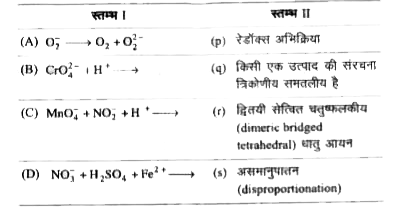लोहे पर जंग का लग्न निम्न प्रकार होता है
2H++2e−+12O2−−→H2O(l)E∘=+1.23VFe2++2e−−−→Fe(s)E∘=−0.44V
प्रक्रिया के लिए ΔG∘ का मान होगा
−322 किलो जूल/मोल
−161 किलो जूल/मोल
−152 किलो जूल/मोल
−76 किलो जूल/मोल
The correct Answer is:A
अभिक्रियाएँ :
(i) Fe(s)→Fe2+(l)+2e−,E∘=+0.44V
तथा ΔG∘1=−nE∘F=−2×0.44×F
(ii) 2H+(g)+2e−+12O2→H2O(l),E∘=+1.23V
तथा ΔG∘2=−2×(+1.23)×F
पूर्ण सेल अभिक्रिया :
Fe(s)+2H++12O2→Fe2++H2O(l)
∴ ΔG∘3=ΔG∘1+G∘2
=(−2×0.44×F)+(−2×1.23×F)
=−0.88F−2.46F=−3.34F
=−3.34×96500 जूल
= -322.31 किलोजूल ≈−322 किलोजूल
Topper's Solved these Questions
- रेडॉक्स अभिक्रियाएँ एवं विधुत रसायन BOOK - JEE Main & Advanced (Hindi Medium)CHAPTER - रेडॉक्स अभिक्रियाएँ एवं विधुत रसायन EXERCISE - मैट्रिक्स-सुमेल प्रकार
3 Videos
- रेडॉक्स अभिक्रियाएँ एवं विधुत रसायन BOOK - JEE Main & Advanced (Hindi Medium)CHAPTER - रेडॉक्स अभिक्रियाएँ एवं विधुत रसायन EXERCISE - बहुविकल्पीय प्रश्न II
3 Videos
- रासायनिक बलगतिकी BOOK - JEE Main & Advanced (Hindi Medium)CHAPTER - रासायनिक बलगतिकी EXERCISE - विश्लेषणात्मक प्रश्न
18 Videos
- विलयनBOOK - JEE Main & Advanced (Hindi Medium)CHAPTER - विलयनEXERCISE - (विश्लेषणात्मक प्रश्न)
11 Videos
Similar Questions
स्तम्भ I' में दी गयी अभिक्रियाओं का 'स्तम्भ II' में दी गयी उनकी प्रकृति/उत्पाद के प्रकार से मिलान कीजिए |

View Solutionएक जलीय विलयन में NO−3 आयन के अपचयन के लिए E∘ का मान + 0.96 V है | कुछ धातुओं के आयनों के E∘ नीचे दिए गए हैं
V2+(aq)+2e−→VE∘=−1.19VFe3+(aq)+3e−→FeE∘=−0.04VAu3+(aq)+3e−→AuE∘=+1.40VHg2+(aq)+2e−→HgE∘=+0.86V
जलीय विलयन में NO−3 द्वारा ऑक्सीकृत होने वाला/वाले धातु युग्म है (हैं)
View Solutionएक प्रथम कोटि की अभिक्रिया 10 मिनट में 20% पूर्ण होती है। गणना कीजिए
(i) अभिक्रिया का विशिष्ट वेग स्थिरांक
(ii) अभिक्रिया के 75% पूर्ण होने में लगा समय।
View Solutionएथेनॉल तथा मेथेनॉल का वाष्प दाब क्रमश: 44.5 तथा 88.7 mm Hg है। समान तापक्रम पर 60 ग्राम एथेनॉल को, 40 ग्राम मेथेनॉल के साथ मिश्रित करके एक आदर्श विलयन बनाया जाता है। विलयन के कुल वाष्प दाब की तथा वाष्प में मेथेनॉल के मोल प्रभाज (mole fraction) की गणना कीजिए।
View SolutionThe rusting of iron takes place as follows: 2H^(+) + 2e + 1//2O(2) rarr H_(2)O_((l)), E^(@) = +1.23 V Fe^(2+) + 2e rarr Fe_((s)), E^(@) = -0.44 V The DeltaG^(@) for the net process is :
View SolutionGiven standard electode potenitals Fe^(2+) + 2e^(-) rarr Fe, E^@ =- 0. 44 V ………………(1) Fe^(3+) + 2e^(-) rarr Fe, E^@ =- 0. 036 V ………….(2) The standard electrode pptential E^@ for Fe^(2+) + e rarr Fe^(2+) is.
View SolutionThe half-cell reaction for the corrosion, {:(2H^(+)+,(1)/(2)O_(2)+2e^(-) rarr H_(2)O,,,E_(@) = 123 V),(,Fe^(2+)+2e^(-) rarrFe(s),,,E^(@) = -0.44 V):} Find the Delya G^(@) (in kJ) for the overall reaction :
View SolutionThe rusting of iron takes place as follows :
2H⊕+2e−+12O2→H2O(l), Ec−=+1.23V
Fe2++2e−→Fe(s), Ec−=−0.44V
Calculae ΔGc− for the net process.
View SolutionIf the half cel reactions are given as
(i) Fe2+(Aq)+2e−→Fe(s),E∘=−0.44V
(ii) 2H+(sq)+12O2(g)+2e−→H2O(l)E∘=+1.23V
The E∘ for the reaction
Fe(s)+2H++12O2(g)→Fe2+(g)→Fe2+(aq)H2O(l) will be
View SolutionIf the half cell reactions ae given as (i) Fe^(2+)(aq)+2e^(-) rarrFe(s),E^(@)=-0.44 V (ii) 23H^(+) (aq)+1//2O_(2)(g)+2e^(-)rarrH_(2)O(l),E^(@)=+1.23V The E^(@) for the reaction Fe(s)+ 2H^(+)(aq)+1//2 O_(2) (g) rarr Fe^(2+) (aq)+H_(2)O (l) is
View SolutionIf the half cel reactions are given as
(i) Fe2+(Aq)+2e−→Fe(s),E∘=−0.44V
(ii) 2H+(sq)+12O2(g)+2e−→H2O(l)E∘=+1.23V
The E∘ for the reaction
Fe(s)+2H++12O2(g)→Fe2+(aq)+H2O(l) will be
View Solutionआयरन पर जंग लगने की प्रक्रिया निम्न है -
2H++2e−+O2→H2O,E0=1.23V
Fe2++2e−→Fe,E0=−0.44V
इसके लिए ΔG∘ की गणना कीजिए
View SolutionThe standard electrode potential of the half cells are given below : Zn^(2+)+ 2e^(-) rarr Zn(s), E^(o) = - 7.62 V Fe^(2+) + 2e^(-) rarr Fe(s) , E^(o) = -7 .81 V The emf of the cell Fe^(2+) + Zn rarr Zn^(2+) + Fe will be :
View SolutionThe rusting of iron takes place as follows : 2H^(+) + 2e^(-) + (1)/(2)O_(2)(g) rarr H_(2)O (l) E^(@) = + 1.23 V Fe^(2+) + 2e^(-) rarr Fe(s) E^(@) = - 0.44 V Calculate Delta G^(@) for the net process
View SolutionE^(@) for Fe^(2+) + 2e to Fe is -0.44 V , E^(@) for Zn^(2+) + 2e to Zn is - 0.76 V . Then
View Solution
